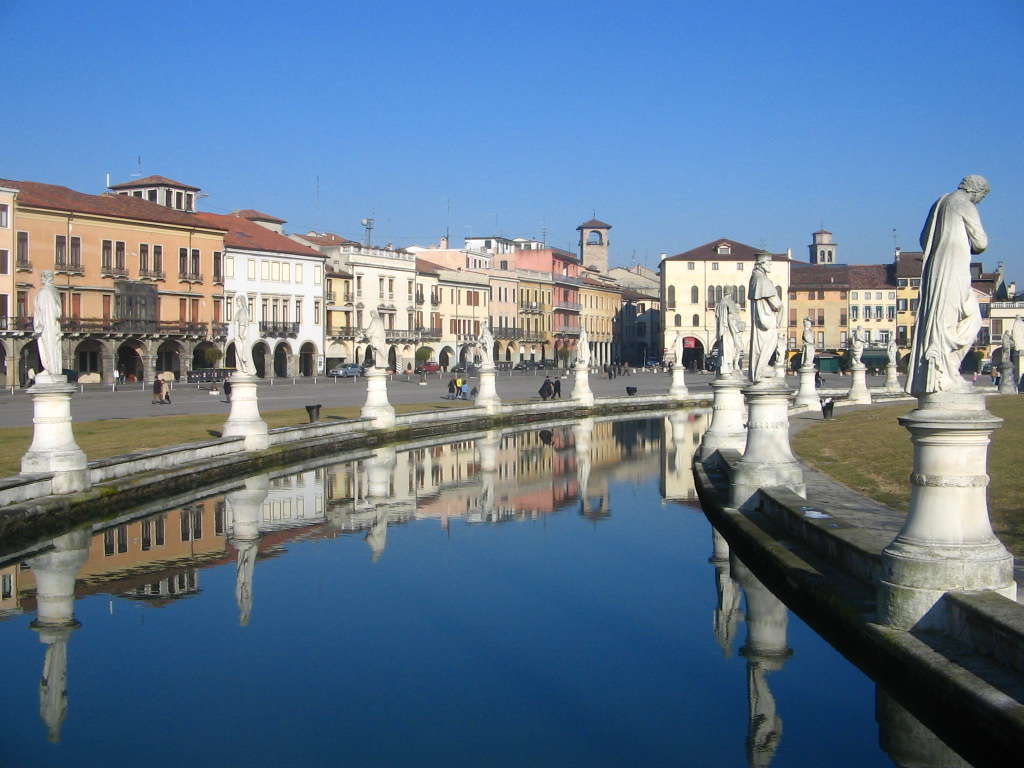The City of Padua
Beside a developing town in full swing, there was the foundation of the University in 1222, as a consequence of a student migration left from Bologna to the city of Padua. One of the most reliable and lasting image developed: that of Padova as an excellent centre for studies and culture. During 1500 Galileo Galilei himself acquired the chair of Maths. Still at present it remain famous from an artistic point of view both for the anatomy room which has remained untouched like it was when Galileo taught there, and for the University botanical gardens, created during the sixteenth century, which is the first one in the world to be born in order to be open to public.
Between 1700 and 1800 other two important monuments representing this town were built: Prato della Valle and Caffè Pedrocchi Padua:
the first one is a majestic triangular square surrounded by a long line of Palaces above which the cupolas of St. Giustina Church stand out. In ancient times it was an uncultivated area subject to flooding, which was used for feasts and celebrations. In 1775 the superintendent of the Serenissima, Andrea Memmo, decided the reclamation of the area and entrusted such enterprise to Domenico Cerato, architecture lecturer at the University of Padua. By referring to the great tradition of the Veneto related to the harmonic equilibrium between nature and architecture, he thought of a large egg-shaped garden, surrounded by a canal and marked by a long series of statues devoted to renowned characters of the town.
Caffè Pedrocchi Padua has been famous since its inauguration (1831) for its neo-classical forms, by Francesco Jappelli. Thanks to its central position, not very far from Piazza delle Erbe, and to its closeness to the University, it soon became a meeting place for students, tradesmen, intellectuals, men of letters and politicians. Defined ‘Café with no doors’ because it was open also by night, it is currently a lively meeting and cultural place where five concerts per week are kept, not including Sundays and Mondays. We suggest you a stop for the aperitif, accompanied by gastronomic specialities every day. The chief speciality of the Café is the mint coffee.
PADUA TODAY: THE MUSEUMS
The town also looks onto future, with a very intense economic and cultural living.
There are many music, artistic and theatre shows, in which, every year people can take part, which make Padua a lively centre. Moreover, the town has got a wide range of museums and collections, ranging from the traditional collections of works of art to unique collections in Italy.The Civic Eremitani Museums: prepared in the beautiful restored rooms of the ex monastery of the Eremitani monks, they offer a wide view on the Roman Palaeovenetian history of the town, as well as an extraordinary collection of paintings made between the Thirteenth and the Nineteenth centuries by the great masters of the Italian painting, among whom Giotto, Guariento, Bellini, Tintoretto and many others.
The Applied and decorative Arts Museum and Bottacin Museum: in the historical Palace Zuckermann more than two thousand objects of Applied and decorative Arts are displayed: they belong to the collections of the Medieval and Modern Art Museum.
The Diocese Museum of Padua: a wing of the Episcopal Palace of the Fifteenth century has got precious collections of sacred art, including some ancient manuscripts and incunabula, works of art and jewellery, holy vestments. The visit includes the impressive Hall of the Bishops and the evocative St. Maria degli Angeli Chapel.
The Risorgimento and Contemporary Age Museum: prepared in the rooms of the noble floor of Caffé Pedrocchi, it testifies events and protagonists of a century and a half of national history and of the history of Padua, from the fall of the Republic of the Veneto (1797) to the promulgation of the Republican Constitution (1948).
The Antoniano Museum: inaugurated in 1995 it shows the public the best of the collection of paintings, sculptures, holy vestments and objects made for the Basilica and the Monastery of the Saint or being the result of legacies by religious men and devotees. Go to the description of the monument.
The Precinema Museum – Minici Zotti Collection: a particular exhibition of optical instruments and other collections devoted to the historical memory of archaeology of the Cinema and the Magic Lantern. Go to the description of the monument.
APERITIF AND GASTRONOMY
For the relevant presence of students Padova is also rich in premises in the latest fashion and taverns smacking of ancient times where you can taste the typical local aperitif: the spritz. In the several restaurants of the centre you can taste the local cooking. The age-old gastronomic tradition of Padua has got its origins in the natural products of the family garden, of the farmyard, of the vineyard, in the perch of salami, in the season fruits and, in some areas, in the spontaneous herbs. The recipe-book draws its historical origins in the times of the Obizzi, the Carraresi and the Contarini families, who succeeded in creating and increasing the value of delicious dishes, redeeming the naturalness of the ingredients. Nonetheless it is almost impossible to speak of homogeneity in the cooking of Padova, as the area of the province in its diversifications of lagoon, valleys, hills, rivers and plains, offers a great variety of ingredients to cooking, being different in each area. Few are the dishes handed out uniformly: among these, perhaps the most famous is the ‘boiled meat in Padua style’ in the version codified by the German Mattia Giegher in the Seventeenth century.
